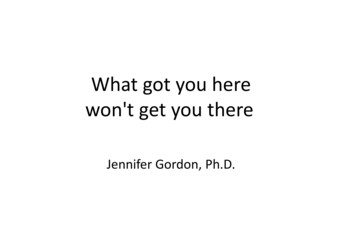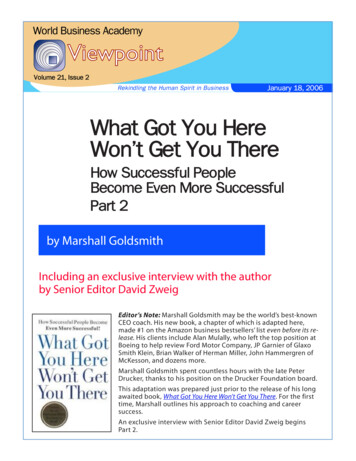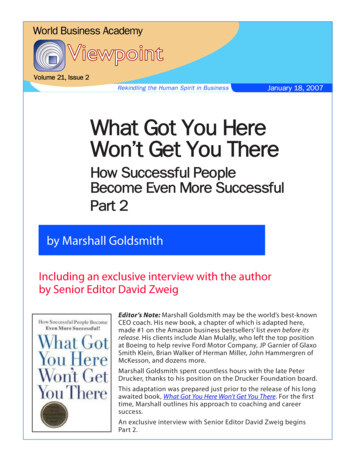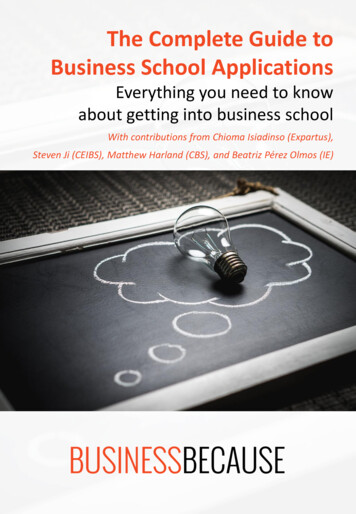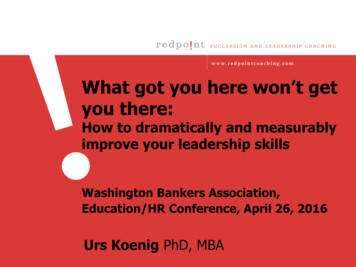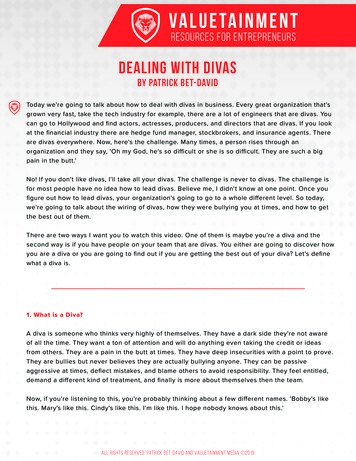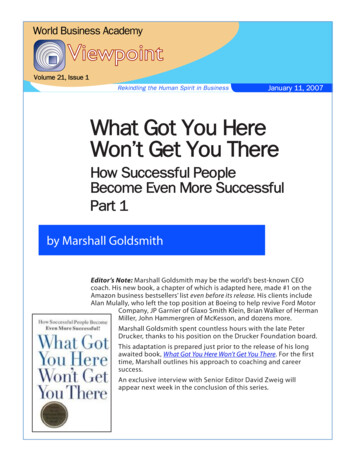
Transcription
Volume 21, Issue 1January 11, 2007What Got You HereWon’t Get You ThereHow Successful PeopleBecome Even More SuccessfulPart 1by Marshall GoldsmithEditor’s Note: Marshall Goldsmith may be the world’s best-known CEOcoach. His new book, a chapter of which is adapted here, made #1 on theAmazon business bestsellers’ list even before its release. His clients includeAlan Mulally, who left the top position at Boeing to help revive Ford MotorCompany, JP Garnier of Glaxo Smith Klein, Brian Walker of HermanMiller, John Hammergren of McKesson, and dozens more.Marshall Goldsmith spent countless hours with the late PeterDrucker, thanks to his position on the Drucker Foundation board.This adaptation is prepared just prior to the release of his longawaited book, What Got You Here Won’t Get You There. For the firsttime, Marshall outlines his approach to coaching and career success.An exclusive interview with Senior Editor David Zweig will appear next week in the conclusion of this series.
The Success Delusion, orWhy We Resist ChangeAfew years back the disability insurance company Unum ran a wonderfulad that depicted a grizzly bear on its rear legs, waist-deep in a mountainstream. Every sinew in its neck was straining, its eyes glared, and its enormous teeth were bared. Inches away from the gaping jaws of that bear, a fatpink salmon was jumping upstream.The caption read: YOU PROBABLY FEEL LIKE THE BEAR. WE’D LIKE TO SUGGEST YOU’RE THE SALMON.While the ad was designed to sell an insurance product, it struck me as apowerfully graphic statement about the way we delude ourselves in theworkplace. Through the years, I’ve noticed how so many executives, eventhose who have risen to the level of CEO or other high positions: Overvalue their contribution to a project Assume credit or recognition for the victories and success that mayrightfully belong more to other people Have an overinflated view of their standing and skills Conveniently ignore the miscues, cul-de-sacs, and ill-conceived timewasters they have created Unconsciously overinflate the positive financial impact of their actionsbecause they tend to lighten the hidden and real costs that come withwhat they do.Very successful people seem to think, “We own the benefits; someone elseowns the costs.”For all us, these delusions would not appear if we weren’t frequently successful. Success brings positive reinforcement, and we easily leap to justify theexpectation that past success predicts an ongoing record of brilliance.Such delusional thinking is not all bad. It provides a number of benefits:confidence in the face of risk or danger; and blindness to doubt and the possibility of failure. If we weren’t so selectively perceptive, we might just stay inbed all day.These delusions shift from assets into liabilities only when we need tochange in order to move to a new level of performance. We sit around, godlike, convinced of our supreme excellence, and when people suggest wealter our approach, they are regarded with pure bafflement.
The response runs through three phases:First, we presume the other party must be confused. Surely they are mixingus up with someone else. They don’t know what they’re talking about. Certainly, some people must change, but we are not among them.Next, we become dimly aware that there might be some evidence underlying their suggestion that we change. So we dive into denial mode. If thiscriticism applied to us, we would not be the successes we are today. Oursupposed ‘flaws’ can’t really matter that much. If they did, how could we beso successful?In phase three, everything else having failed, we go on the attack. Shoot themessenger. “Why should a winner like me,” we ask, “give the time of day to aloser like you?”Those responses only skim across the surface of the challenge; they are onlydenial mechanisms. But it’s also known that highly successful people sharefour other attitudes about themselves. They put an unusually positive slant on:a. their past performanceb. their uncanny knack for belief that their personal contribution is a majorfactor in the success of any process they’re involved with (not luck, random chance or external factors).c. the surety that their prior success will extend well across the horizoninto the futured. their belief in their mastery of their own destiny.Denial-plus-delusion is a highly explosive compound, the Semtex of the corner office. And more often than not, the detonator is the need to change.These four beliefs contain the paradox of success. Successful people believein their own success. But these beliefs also carry the seed of our failures:the beliefs that carried us here — which can be a pretty great place — willimpair our ability to progress there — which can be performance at the nextlevel. Let’s examine how each of these beliefs systems can hold us back fromchanging our sure-fire formula for success.FIRST BELIEF: I HAVE SUCCEEDEDIn my work with successful people over the past few decades, I have noticedthey seem to have one mantra coursing through their heads. If you could putsome sort of stethoscope to their skulls and somehow “hear” their thoughts,these are the words that would come out: “I have succeeded. I have succeeded. I have succeeded.” They believe in their talent. And in their skills.You might think the preceding paragraph describes someone else. Notyou! But now ask yourself how you manage to get out of bed each day andcharge into work. Although success doesn’t always come your way, is thatwhat you remember? Do you run a tape of every rejection, screw-up, andfailure that you’ve touched? Likely not. So how do you stoke that daily fireof optimism and competitive spirit? You do it by selecting the tapes you Whywhat gotyou herewon’tget youthere.
Were it notfor this“charitable”selfperception,we might notsee a reasonto attemptmuch ofanything.Ever.run: you leave the failure reel in the stockroom and constantly replay your highlight film. Let’s look at the performances where you astounded all onlookers and shone as the star we all know you can be. The dazzling commentyou launched five minutes before the meeting began. Why, your brilliancedominated the meeting. You could sit back and watch. And how about thatmemo that the CEO insisted the entire executive staff read before taking onemore step! You’ve re-read that one more than five times, and it just gets better and better. No matter what the plot is, we like to be the hero who ridesoff into the sunset, and sing our song of victory to anyone who will listenlong enough.Listen to your successful friends. Do they regale you with their blooper reel?Or do they loop their Greatest Hits? Surely it’s the latter.Of course nature has a purpose behind this. Were it not for this “charitable”self-perception, we might not see a reason to attempt much of anything. Ever.A major league player provided me with a great example of this phenomenon. Every batter has at least a short list of pitchers whom they can seemingly knock around the park at will. “When I face a pitcher whom I’ve hit wellin the past, I always go up to the plate thinking I ‘own’ this guy. That gives meconfidence,” the player told me.This should not surprise you. Successful people always see the past successes as prologues to their next string of victories. But the next thing he saiddid surprise me, when I asked about pitchers whom he doesn’t hit as well.“It’s just the same. I go up to the plate thinking, yeah, I can hit this guy. Matter of fact, I’ve gotten hits off lots of guys better than him.”This demonstrates an important point about successful people: they use theirpast successes to support their positive attitude even when the data suggeststhey’re due for a fall. Successful people drink from a cup that’s half full.Even in a team undertaking, they tend to think it was their contribution thatmost contributed to the group’s success.On one occasion I made this point by telling a group of doctors that I haddone extensive research which had proven that exactly half of all MDs hadgraduated in the bottom half of their medical schools. Two of the doctorsinsisted that this was impossible!Another time I asked three business partners to tell me the percentage ofprofits each of them brought into the partnership. The aggregate answer exceeded 150 percent! Now I happened to know the true figures, but each manthought he alone brought in more than half.There’s nothing wrong with this attitude. Winners show it all the time. But aspositive as this belief can be, it also becomes a serious obstacle when someone has to make major behavioral changes.In my career I have asked 50,000 participants in my training programs torate their performance against their peers. 80 to 85 percent of them declarethemselves to be in the top 20 percent. Seventy percent declare themselvesto be in the top 10 percent. If you shift the population to people with higher
perceived social status, such as investment bankers, airline pilots, or doctors,90 percent of them place themselves in the top 10 percent of their profession.Now, imagine trying to tell someone so delusional that they are doing something wrong and they are going to need to change.SECOND BELIEF: I CAN SUCCEED.Put another way, “I have the confidence to succeed.”Successful people believe that they can make anything happen. Whenpressed they will admit that they cannot bend a fork in the next room withthe sheer power of mind. But when it comes to business, they believe theycan tip the tables in their favor through force of their own will, talent, skill,personality, or brainpower.Sometimes in sports, certain players like Michael Jordan would demand toget the ball at a crucial instant. Other players after the game say, “I’m gladthey gave it to him. I wouldn’t have wanted it in a situation like that.”This is the essence of self-efficacy. The successful person says, “I see an opportunity, not a threat. I enjoy uncertainty. I love to take a smart risk. I likelarge risks because there are larger returns when I win.” Whenever they can,they bet on themselves.Notice that the word “luck” appears nowhere. Successful people have a high“internal locus of control.” They believe they are captains of their ships andmasters of their destiny. Fate affects other people. Successful people drivetoward the goal using motivation, natural ability, and usually hard work— but never luck, random circumstances, or other externalities.A number of years ago six of my business partners asked me to approveof a very large deal. As the senior partner, my agreement was necessary. Itold them it was an idiotic idea and I was thoroughly opposed to it. Theypushed and pushed and I reluctantly agreed to go along with their crazyscheme. Subsequently I received the largest lump sum check of my life — allfrom this deal that I opposed. Amazingly, when told this story, my successful friends attributed my windfall to my years of hard work and dedication.It was just dumb luck. But successful people just don’t see luck. They thinkthat individual motivation and ability crowns us with success, even when the opposite is true.As a Buddhist, I have a somewhat different view of cause and effect. In ourWestern society, however, successful people think that a link always existsbetween where they are and what they’ve done. It’s only an empoweringdelusion.The alternative to this delusion is worse. Consider people who buy lotterytickets. Everyone knows that state-run lotteries are “regressive taxes” on lower income wage earners. People who “knowledgeably” play the lottery knowthat it’s a matter of pure luck, with very low probability of a positive payout.You don’t see chauffeurs in 7-11 buying lottery tickets for their employers.They might buy them for themselves, but that’s why they’ll always be in the S uccessfulpeopledon’tbelieve inluck.
front seat of the car. Inveterate lottery players think they might get lucky andwin millions if, over the years, they buy enough tickets. Studies show suchpeople tend to be neither high achievers nor high wage earners.Similarly, one often reads about lottery winners who go bankrupt. The samebelief system that got them in front of the lottery machine leads them tomake irrational investment decisions and to pursue crazy investments. Theythink that luck — rather than skill or intelligence — will strike twice andmake them even richer. They lack the belief they can succeed on their owntalents — and luck is all that’s left.Just as lottery addicts believe in their own luck or random chance, successfulpeople believe in their own talent and in themselves. This otherwise positivebelief can present a real challenge when it comes to behavioral change. Thelogic goes like this: “I am a big success. I behave in a certain way. I am successful because I behave this way.” The challenge is to bring them to realize thatsometimes their success occurs despite certain elements of this behavior.Manysuccessfulpeopleovercommit.This canbe theirundoing.THIRD BELIEF: I WILL SUCCEED.Put another way, this means, “I am motivated to succeed.”“I have succeeded” refers to the past. “I can succeed” refers to the present. “Iwill succeed” refers to the future. Not only do successful people believe theycan manufacture success, they believe it’s practically due to them.Consequently, successful people often pursue projects for reasons thatmystify everyone else. They set a goal, publicly announce their intention, andthen do “whatever it takes” to win. That’s good. But this same attitude can easilymutate into an excess of optimism. It’s often said, “if you want something done,give it to someone who is busy.” Successful people are busy, and that’s wherethey expose themselves to the danger of overcommitment.Successful people often have difficulty walking away from desirable opportunities. A huge majority of executives with whom I work declare that theyare as busy, or busier, today than they ever have been. Never have I heardone of my clients say, “I don’t have enough to do.” Much of this busy-nessdoes not come from dealing with problems. When I surveyed executivesabout their overcommitment, not one of them said they were trying to “savea sinking ship.” They overcommitted because they were drowning in a sea ofmagnificent possibilities.Has this happened to you? You meet with a big success at work. Suddenly,people emerge from everywhere you want to associate themselves with youand your success. Quite logically, they think that since you pulled off onehuge score you can pull off many more. And they want you to pull it off withthem. Opportunities appear at a dizzying pace. Without enough experienceor discipline you agree to work with all of them. In due course, if you’re notcareful, you will be overwhelmed. That which made you rise will bring aboutyour fall.In my volunteer work, my favorite European client served as Executive Director of one of the world’s leading human services organizations. His mission
was to help the most vulnerable people in the world. Unfortunately (for all ofus), his business was booming. People came to him for help in every manner of project, and he lacked the heart or inclination to say no to anyone.Driven by his belief in his own success, he overpromised and even the most dedicated staff couldn’t deliver on his commitments.Unchecked, this “we will succeed” approach brings about staff burnout, excessive turnover, and a depleted, weakened team. As a leader, my Europeanclient’s biggest challenge was avoiding overcommitment.As with the prior two beliefs, this ‘I will succeed’ approach can devastate thechances for success when the time arrives to change behavior. I will neverapologize for my obsession about following up with clients to learn whetherthey actually get better by using my methods. Almost everyone who attendsmy leadership development programs intends to apply what he or she haslearned upon their return to the job. Most do, and get better! Our researchalso shows that many do absolutely nothing, They may just as well havespent the time watching cartoons on television instead of attending mytraining program.When we asked the “do-nothings” why they didn’t implement the behavioralchanges they promised they would, by far the most common answer is, “I intended to, but I just didn’t have the time to get around to it.” They were overcommitted. They wanted to change. They agreed with the value of changing.They simply ran out of hours every day. When it comes to change, overcommitment can be as serious a problem as believing you don’t need fixing, orthat your flaws are part of the cause for your success.FOURTH BELIEF: I CHOOSE TO SUCCEED.Whatever successful people do, they believe they act in everything as a matter of choice. The more successful they are, the more likely you’ll find a highneed for self-determination. Choosing what we do is commitment. Doingwhat we have to do is compliance.The difference between commitment and compliance appears in any job,even when compensation is unrelated to performance. During my high schooldays back in Kentucky, even a skeptical wisecracking jokester like me couldsee the difference between teachers who had a calling and teachers who onlyhad a job. The best teachers had a calling. They committed to the studentsinstead of submitting to the control of external forces (like a paycheck).Successful people have a distinct dislike for feeling controlled or manipulated. This shows up in my work every day. I may get the greatest advancebuild-up as someone who can help people change for the better — in otherwords, I’m good at helping — but I still meet resistance. I have come toterms with the fact that I cannot make people change. I can only help themimprove at what they choose to change.Rick Pitino, the famous basketball coach, wrote a book called Success is aChoice. He’s right. “I choose to succeed” directly correlates to achievement invirtually any field. People do not stumble across success; they choose it.
It’s verydifficult toconnectpriorsuccesswith futurepersonalchange.Unfortunately, it’s not easy to get people to connect “I have chosen to succeed” with “ and I choose to change.” It requires turning that powerful commitment upside down. Easy to say, hard to do. The stronger our belief thatour behavior results from our own choices and commitments, the weaker isthe desire to change our behavior.The reason for this is one of the best-researched principles in psychology.Cognitive dissonance refers to the difference between what we believe andwhat we see or experience in real life. A simple fact underlies the theory. Themore we commit to the belief that something is true, the less likely we areto believe that its opposite is true, even if overwhelming evidence shows usthat we are wrong. For example, if you believe your colleague Larry is a fool,you will filter Larry’s actions through that belief. No matter what he does,you’ll view him through a prism that serves only to confirm that he is a fool.Even when he’s not foolish, you’ll interpret that as the exception that provesthe rule that Larry is a fool. It may take years for Larry to overcome your perception. That’s how cognitive dissonance applies to others. In the workplaceit can be disruptive and unfair. But it’s everywhere.Yet when successful people apply cognitive dissonance to themselves, itactually works in their favor. The stronger our belief and our commitmentto the truth of something, the less likely we are to accept that its oppositeis true, even when the facts show we may have taken the wrong direction.That’s why successful people don’t crumble or waver when the going getsrough. Thanks to their commitment to their goals and beliefs, they view reality through rose-colored glasses. In many situations, that’s their salvation.Their deep personal commitment gives other people the courage to stay ontheir mission.Naturally, this same dedication can torpedo successful people when the timecomes to change their tack.Next Week: The Fifth Belief, the Conclusion, and an exclusive interview with Marshall Goldsmith.ABOUT THE AUTHORMarshall Goldsmith is a world authority in helping successful leadersachieve positive, measurable change in behavior: for themselves, theirpeople and their teams.Recently, the American Management Association named Marshall one of50 great thinkers and leaders who have influenced the field of management over the past 80 years. His work has been featured in a HarvardBusiness Review interview, Business Strategy Review cover story (from theLondon Business School) and a New Yorker profile. He has appeared in TheWall Street Journal as one of the top ten executive educators, in Forbes asone of five most-respected executive coaches, in The Economist as oneof the most credible consultants in the new era of business, and in FastCompany as America’s preeminent executive coach. His work has received
recognition from almost every professional organization in his field, including the Academy of Management, the American Society for Trainingand Development, and the Society for Human Resource Management.Dr. Goldsmith is one of the few consultants who have been asked towork with over 70 major CEOs and their management teams. He conducts workshops for executives, high-potential leaders and HR professionals. He has been asked to teach in executive education programs atDartmouth, Michigan, Wharton, UCLA, MIT, Oxford and Cambridge. HisPh.D. is from UCLA.He is a founder of Marshall Goldsmith Partners, which (in alliance withHewitt Associates) is providing coaching for leaders around the world.He served as a member of the Board of the Peter Drucker Foundation forten years.Recently, the graduate business school at Alliant University was namedafter him.What Got You Here Won’t Get You There 2007 Marshall Goldsmith. Adapted by permission of the author.All rights reserved.Viewpoint 2006 World Business Academy, 428 Bryant Circle, Suite 109, Ojai, CA 93023Academy Phone 805 640-3713 Fax 805 640-9914 Website www.worldbusiness.orgSenior Editor, David Zweig, david@worldbusiness.org Phone 510 547-3223
What Got You Here Won't Get You There How Successful People Become Even More Successful Part 1 January 11, 2007 Volume 21, Issue 1 Editor's Note: Marshall Goldsmith may be the world's best-known CEO coach. His new book, a chapter of which is adapted here, made #1 on the Amazon business bestsellers' list even before its release.


